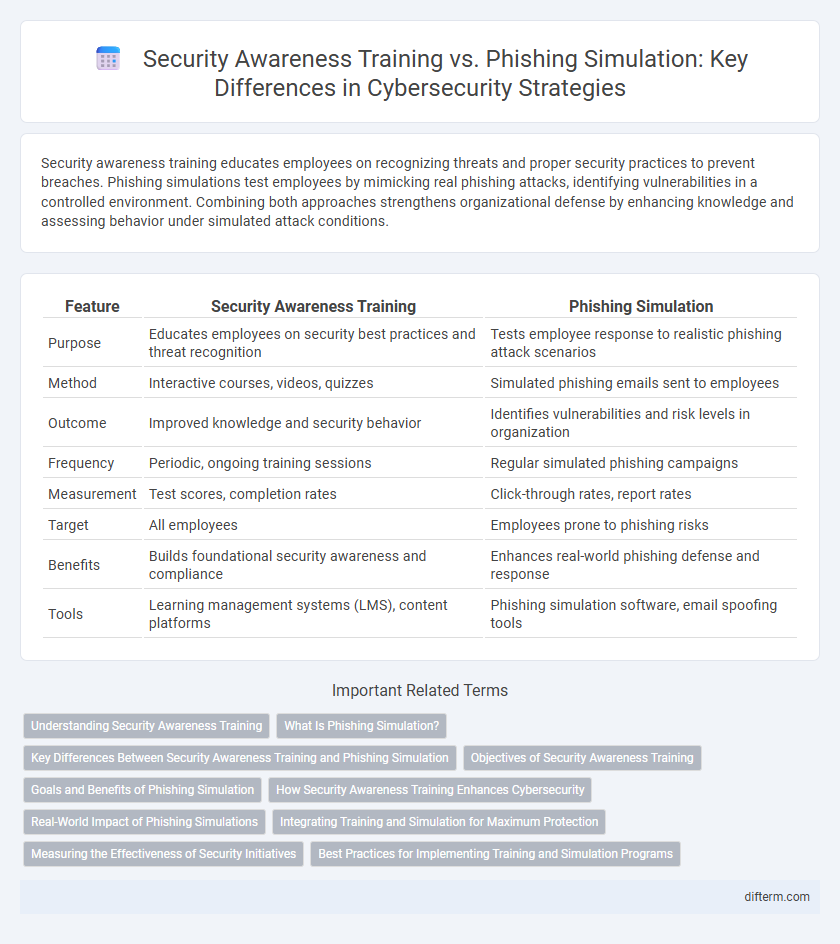Security awareness training educates employees on recognizing threats and proper security practices to prevent breaches. Phishing simulations test employees by mimicking real phishing attacks, identifying vulnerabilities in a controlled environment. Combining both approaches strengthens organizational defense by enhancing knowledge and assessing behavior under simulated attack conditions.
Table of Comparison
| Feature | Security Awareness Training | Phishing Simulation |
|---|---|---|
| Purpose | Educates employees on security best practices and threat recognition | Tests employee response to realistic phishing attack scenarios |
| Method | Interactive courses, videos, quizzes | Simulated phishing emails sent to employees |
| Outcome | Improved knowledge and security behavior | Identifies vulnerabilities and risk levels in organization |
| Frequency | Periodic, ongoing training sessions | Regular simulated phishing campaigns |
| Measurement | Test scores, completion rates | Click-through rates, report rates |
| Target | All employees | Employees prone to phishing risks |
| Benefits | Builds foundational security awareness and compliance | Enhances real-world phishing defense and response |
| Tools | Learning management systems (LMS), content platforms | Phishing simulation software, email spoofing tools |
Understanding Security Awareness Training
Security Awareness Training equips employees with essential knowledge about cyber threats, safe online behavior, and organizational policies to minimize security risks. It covers phishing identification, password management, data protection, and compliance requirements, fostering a security-conscious culture. Comprehensive training enhances employees' ability to recognize and respond effectively to cyber attacks, reducing the likelihood of successful breaches.
What Is Phishing Simulation?
Phishing simulation is a controlled, safe exercise designed to mimic real-world phishing attacks, helping organizations assess employee susceptibility to social engineering threats. It involves sending fake phishing emails to employees to identify vulnerabilities and reinforce proper response behaviors. Effective phishing simulations improve security awareness by providing practical, experiential learning that reduces the risk of successful cyberattacks.
Key Differences Between Security Awareness Training and Phishing Simulation
Security Awareness Training focuses on educating employees about cybersecurity principles, policies, and best practices to reduce human error and enhance overall security posture. Phishing Simulation specifically tests employee vulnerability by sending fake phishing emails to evaluate their ability to recognize and respond to phishing attempts effectively. While training builds foundational knowledge, simulations provide real-world assessment and reinforce learning through practical experience.
Objectives of Security Awareness Training
Security Awareness Training aims to educate employees on recognizing and mitigating cyber threats, fostering a security-conscious culture to reduce human error and insider risks. Key objectives include improving knowledge of phishing tactics, promoting safe online behaviors, and ensuring compliance with cybersecurity policies and regulations. This foundational training empowers staff to act as a critical defense layer against data breaches and cyberattacks.
Goals and Benefits of Phishing Simulation
Phishing simulation aims to assess and enhance employees' ability to recognize and respond to malicious emails by replicating real-world phishing attacks in a controlled environment. This practical approach reinforces security awareness training by providing measurable data on user susceptibility, enabling targeted improvements in cybersecurity behavior. Organizations benefit from reduced risk of credential compromise and data breaches through continuous evaluation and adaptive learning based on simulation results.
How Security Awareness Training Enhances Cybersecurity
Security Awareness Training significantly strengthens cybersecurity by educating employees on identifying and responding to threats such as malware, ransomware, and social engineering attacks. This training fosters a security-conscious culture, reducing the risk of human error and improving adherence to organizational policies and compliance standards like GDPR and HIPAA. By continuously updating participants on the latest cyber threats and best practices, Security Awareness Training enhances overall risk management and incident response capabilities.
Real-World Impact of Phishing Simulations
Phishing simulations provide employees with hands-on experience in identifying and responding to phishing attempts, significantly reducing the risk of credential theft and data breaches. These simulations reveal real-world vulnerabilities by exposing users to realistic attack scenarios, which traditional security awareness training alone may not effectively address. Organizations implementing regular phishing simulations report up to a 70% decrease in click rates on malicious links, demonstrating measurable improvement in security posture.
Integrating Training and Simulation for Maximum Protection
Integrating security awareness training with phishing simulation significantly enhances an organization's defense against cyber threats by combining theoretical knowledge with practical experience, promoting behavioral change. Regular phishing simulations provide real-time feedback and identify vulnerabilities, allowing tailored training programs to address specific weaknesses. This combined approach fosters a security-conscious culture, reducing the risk of successful phishing attacks and improving incident response effectiveness.
Measuring the Effectiveness of Security Initiatives
Measuring the effectiveness of security initiatives requires analyzing key metrics such as employee click rates on simulated phishing emails and their retention of training materials over time. Security Awareness Training improves overall knowledge and behavior by providing comprehensive education, while Phishing Simulation offers targeted, real-world testing to identify vulnerable users and reinforce training through practical engagement. Combining both approaches enables organizations to track behavioral changes, reduce risk, and continuously enhance their cybersecurity posture with data-driven insights.
Best Practices for Implementing Training and Simulation Programs
Effective Security Awareness Training integrates regular, role-specific content that reinforces cybersecurity principles and threat recognition. Phishing Simulation complements training by providing realistic, controlled exercises that evaluate employee responses and highlight vulnerabilities. Combining both approaches with continuous feedback and updated scenarios ensures organizations build resilient human defenses against evolving cyber threats.
Security Awareness Training vs Phishing Simulation Infographic

 difterm.com
difterm.com